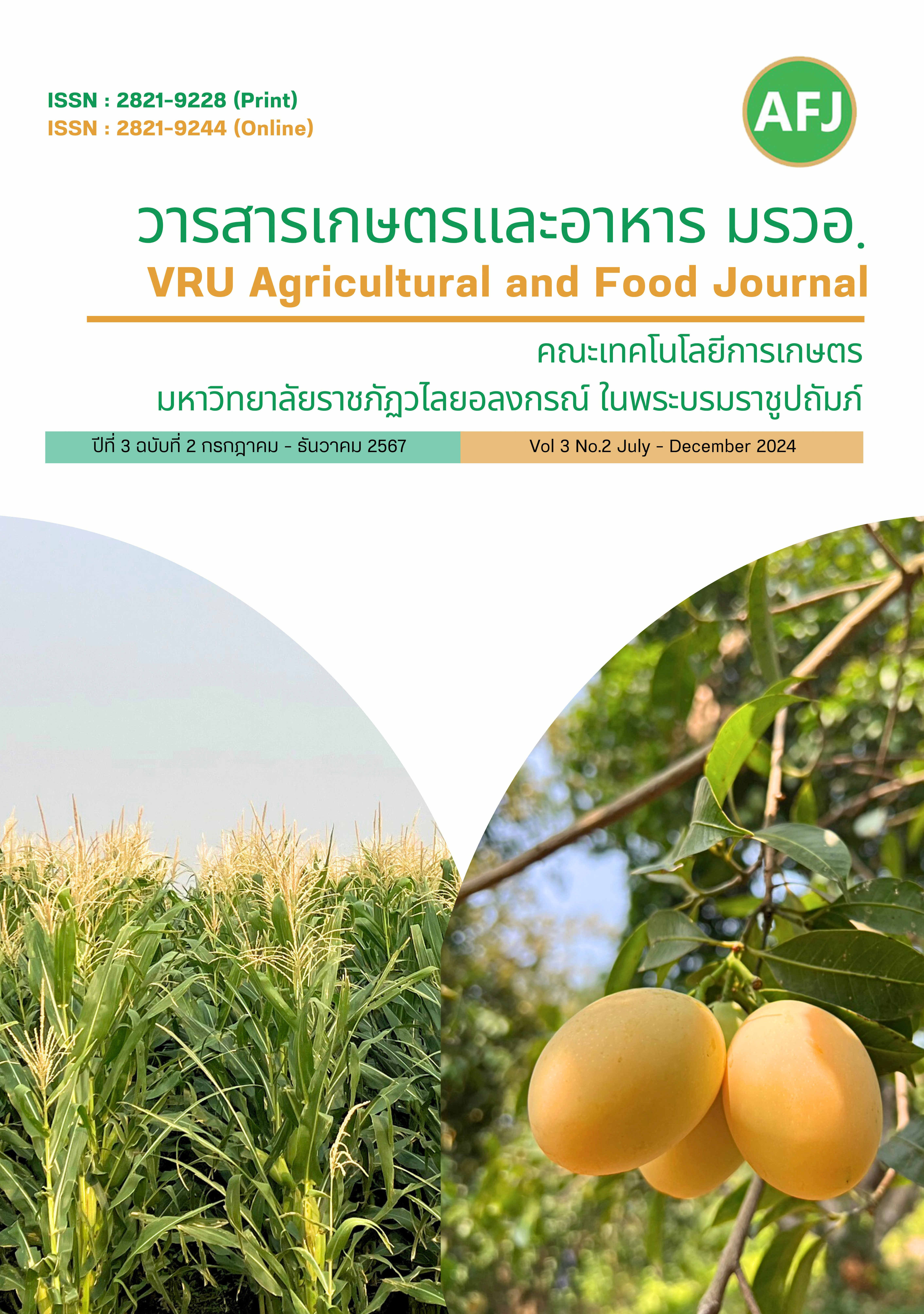Effects of Elite Cassava Lines on Yield, Textural Quality and Consumer Acceptability of Processed Products
Main Article Content
Abstract
Cassava is high in carbohydrates, fiber vitamin and minerals. Hanatee and Rayong 2 are sweet cassava varieties that are popularly consumed fresh. However, both cassava varieties have limitations, low yield and low germination rate, respectively. Therefore, the effect of six cassava lines/varieties, (1) CMRE60-03-02 (2) CMRE60-03-13 (3) OMRE60-01-02 (4) CMRE60-02-12 (5) Hanatee and (6) Rayong 2, on yield, texture and taste of steamed cassava and cassava chips was studied. Randomized complete block design with 4 replications and 6 treatments were used in the experiment. The results showed that CMRE60-03-02 CMRE60-03-13 and OMRE60-01-02 had fresh root yield higher than HANATEE by 35, 4, and 1 percent and higher than Rayong 2 by 39, 6, and 4 percent, respectively. Textural quality of steamed cassava from CMRE60-03-13 and OMRE60-02-12 were similar to HANATEE while cassava chips from OMRE60-02-12 and CMRE60-03-13 were similar to Rayong 2. In addition, all sensory acceptance scores of the respondents to OMRE60-02-12 were higher than HANATEE. and OMRE60-02-12 had all sensory acceptance scores of the respondents similar to Rayong 2. Therefore, the OMRE60-02-12 line is suitable for planting in the field conditions at Rayong Province because it produces fresh root yield that are no different from other lines/varieties and has a low cyanide content. When processed into steamed cassava and cassava chips, it has good taste and physical quality.
Article Details

This work is licensed under a Creative Commons Attribution-NonCommercial-NoDerivatives 4.0 International License.
This article is published under a Creative Commons Attribution-NonCommercial-NoDerivatives 4.0 International License (CC BY-NC-ND 4.0), which allows others to share the article with proper attribution to the authors and prohibits commercial use or modification. For any other reuse or republication, permission from the journal and the authors is required.References
Agronomy Research Institute and Renewable Energy Plants. 2015. Cassava Data Recording Manual. Department of Agriculture. (in Thai)
Amawan, S. 2021. Research Project Report: Research and Development on Cassava Variety Improvement for Increasing Production Efficiency. Department of Agriculture. (in Thai)
Boonseng, O. 2020. Thai Cassava Biology, Production and Utilization. (in Thai)
Cassava and Product Research Center Technopolis Suranaree University of Technology. n.d. Varieties of cassava. Available Source: http://web.sut.ac.th/cassava/?name=1cas_source/cas_source/. January 16 2019. (in Thai)
Chaisri, S., P. Chaisri, E. Sarobol, K. Panitnok, S. Ngamprasitthi and P. Changlek. 2012. Yield Stability of Recommended KU Cassava Varieties Grown in Upper North Region of Thailand. In The 50th Kasetsart University Annual Conference, Bangkok. 318-324 (in Thai)
Hansethasuk, J. 2009. Properties and benefits of cassava roots and starch. Rayong Field Crops Research Center, Department of Agriculture. (in Thai)
Kasetsart University. 2021. Harvesting cassava. Available Source: https://icassava.eng.ku.ac.th/wiki/index.php?title= Harvesting cassava & mobileaction=toggle_view_desktop, October 31, 2023. (in Thai)
Kasetsart University Research and Development Institute. 2015. Cassava: Characterization of cassava types and varieties. Available Source: https://www3.rdi.ku.ac.th/?p=18052. September 24, 2023. (in Thai)
Mulualem, T. and B. Ayenew. 2012. Cassava (Mannihot esculenta Cranz) Varieties and Harvesting Stages Influenced Yield and Yield Related Components. Journal of Natural Sciences Research. 2: 122-129.
Nual-on, S. 2007. Physiology, production and postharvest of cassava. Kalasin Field Crops Research Center, Department of Agriculture. (in Thai)
Petchalanuwat, C., K. Srirath, V. Vichukit, C. Rojanaridpiched, V. Pornprompratan and W. Wattananon. 1996. Effect of Varieties and Harvesting Dates on Yield, Paste Viscosity and Gelatinisation Properties of Cassava Starch. Thai Agricultural research journal 14: 11-17. (in Thai)
Rayong Field Crops Research Center. 1994. Cassava. Field Crops Research Institute, Department of Agriculture, Ministry of Agriculture and Cooperative. Bangkok. (in Thai)
Rodpeawpan, K., C. Inplean, S. Sansanee and T. Kumchoo. 2024. Comparison of Cassava Lines/Varieties and Proper Harvesting Period for Processing to French Fries. Thai Agricultural research journal 42: 131-144. (in Thai)
Rojanaridpiched, C., P. Pulsanguan, S. Phuddachareon, J. Jeamjamnanja, and W. Saengkaewsook. 1987. Study on Planting Season of Cassava. KASETSART JOURNAL: NATURAL SCIENCE 21: 199-125. (in Thai)
Padmaja, G. 1995. Cyanide detoxification in cassava for food and feed used. In Critical Review in food science and nutrition 35: 299-339.
Williams, H.J. and T.G. Edwards. 1980. Estimation of cyanide with alkaline picrate. Journal of the Science of Food and Agriculture 31: 15-22.

